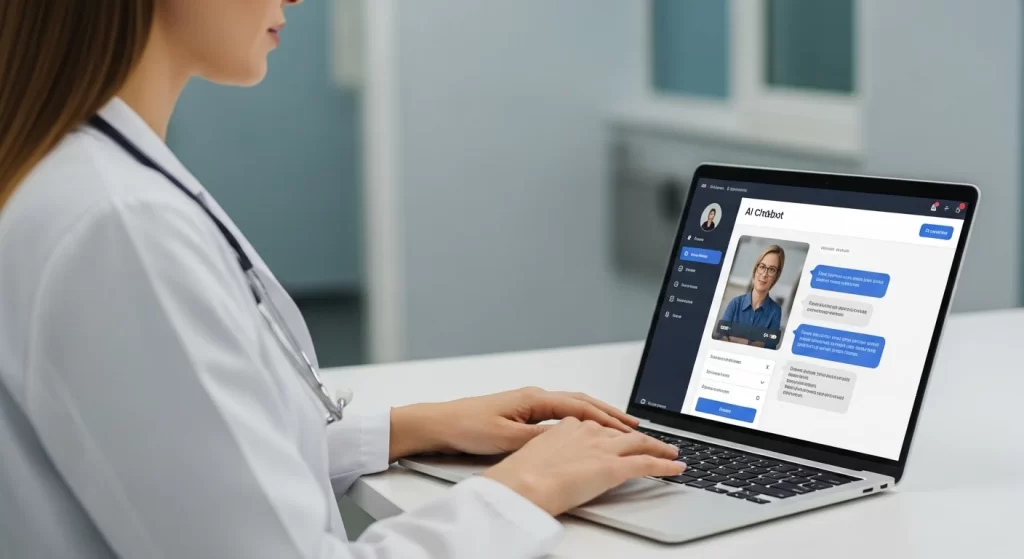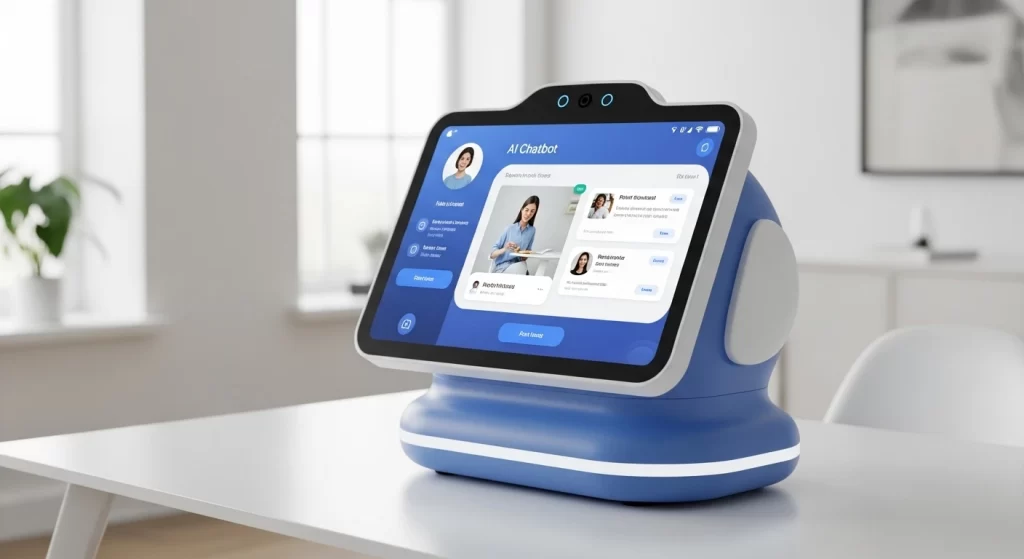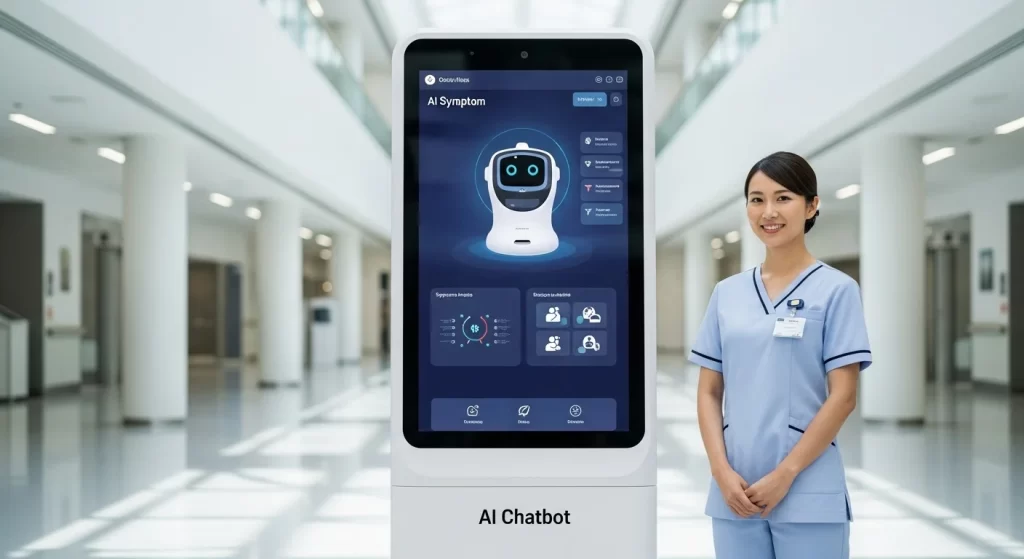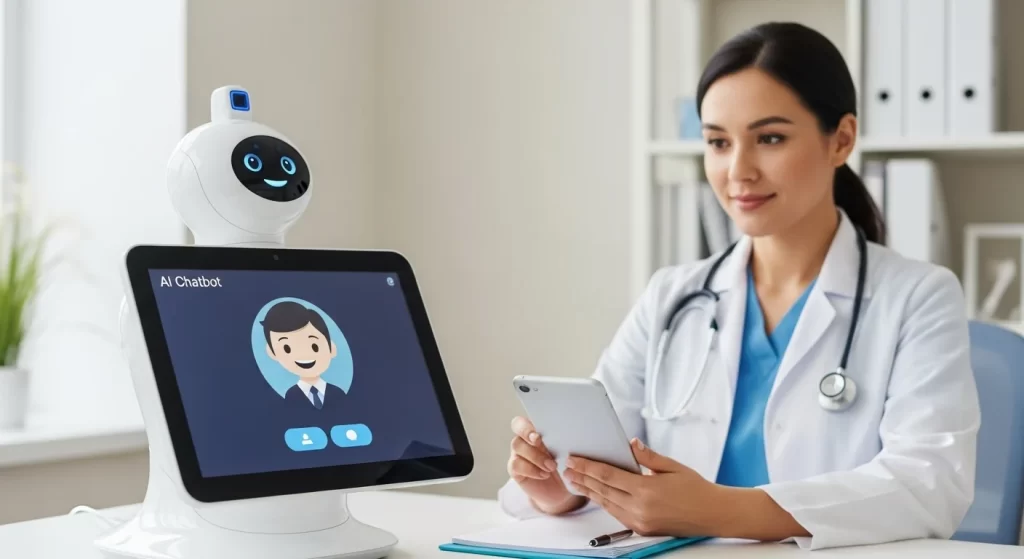The healthcare landscape faces unprecedented pressures: staff shortages, rising operational costs, and growing patient demand for accessible, timely care. As 2025 unfolds, medical Artificial Intelligence (AI) chatbots are emerging as a pivotal technology to address these challenges. These sophisticated conversational agents are rapidly evolving from novelties to indispensable tools. This article explores the dynamic world of medical AI chatbots, highlighting five anticipated to make significant impacts in 2025. We will examine their transformative effects, the technologies powering them, adoption hurdles, and the exciting future they promise.

The medical AI chatbot market’s trajectory underscores its importance. Global market value, already over $1 billion in 2025, is projected to exceed $10 billion within a decade. Some analyses of the broader chatbot market show growth from around $6 billion in 2023 to over $19 billion by 2025, with the healthcare-specific segment expected to reach hundreds of millions by 2026. This growth contrasts with current adoption rates. A Medical Group Management Association (MGMA) poll in April 2025 indicated that only about 19% of medical group practices use chatbots or virtual assistants for patient communication.
This gap between market potential and current implementation suggests an imminent wave of adoption. The financial investment and perceived future value are meeting the practical needs of healthcare providers. The “digital divide” noted by MGMA presents an opportunity, driven by proven ROI in early adoption cases and increasing patient expectations for digital tools. Consequently, 2025 is poised to be a tipping point, where the adoption of medical AI chatbots accelerates, moving them into mainstream healthcare delivery.
Are you looking to leverage the power of AI in your healthcare solutions? SPsoft has extensive experience in developing and integrating healthcare AI agents!
What Exactly is a Medical AI Chatbot? Beyond the Hype
A medical AI chatbot is a sophisticated software program designed to simulate human-like conversations with patients and healthcare providers. These chatbots use a combination of artificial intelligence (AI), Natural Language Processing (NLP), and Machine Learning (ML) to understand, interpret, and respond to health-related inquiries and perform various assistive tasks. They function as intelligent virtual assistants tailored for the healthcare industry, acting as a crucial bridge between technology and patient care.
The functionalities of modern medical AI chatbots are extensive and continue to expand. They are evolving into comprehensive assistants supporting various stages of the patient journey.
Core Functionalities: A Snapshot
- Answering Health Questions. Providing timely information on medical topics, conditions, and treatments.
- Symptom Checking & Triage. Guiding users to assess symptoms, evaluate urgency, and suggest next steps like self-care or seeing a doctor.
- Appointment Management. Automating booking, rescheduling, cancellations, and sending reminders to reduce no-shows.
- Medication Management. Assisting with schedules, reminders, dosage tracking, and information on side effects.
- Mental Health Support. Offering a confidential space for discussing mental health concerns and providing coping strategies.
- Patient Education. Delivering personalized content about diagnoses, treatments, and preventative care.
- Chronic Disease Support. Helping patients manage conditions like diabetes by monitoring vitals and tracking symptoms.
- Navigating Healthcare Systems. Assisting with insurance coverage and billing inquiries.
This breadth of functionality indicates a significant evolution from early FAQ bots. Today’s medical AI chatbots are increasingly integrated into the entire patient experience, from pre-visit interactions to post-visit care. This comprehensive scope suggests a shift towards holistic patient engagement, where chatbots serve as continuous, intelligent support systems.
How AI Chatbots are Revolutionizing Patient Care & Provider Efficiency
The adoption of medical AI chatbots is driven by compelling benefits for both patients and healthcare providers. This dual advantage is a powerful catalyst for their integration into modern healthcare.

For Patients:
- 24/7 Availability & Instant Support. Patients can get answers to health queries anytime, reducing anxiety and delays. Many patients already use healthcare chatbots for health data.
- Reduced Waiting Times. AI chatbots process common queries faster than human agents, cutting down wait times for information.
- Improved Access to Information & Care. These tools bridge geographical and logistical gaps, offering support to remote populations and those with difficulty accessing clinics during standard hours.
- Enhanced Patient Engagement & Empowerment. Personalized information and self-management tools empower patients, leading to better treatment adherence and health literacy. Engagement rates can exceed 90%.
- Anonymity and Comfort. Patients may feel more comfortable discussing sensitive health issues with a non-judgmental AI chatbot.
For Providers & Healthcare Systems:
- Streamlined Administrative Tasks & Reduced Workload. AI chatbots automate tasks like scheduling, reminders, and answering FAQs, freeing up clinical staff and reducing burnout. Operational efficiency can increase significantly.
- Cost Reduction & Resource Optimization. Automation leads to operational cost savings, including reduced spending on large support teams. Annual cost savings from chatbot adoption in healthcare reached billions globally by 2022, with projections for even greater savings in the U.S. healthcare economy.
- Improved Efficiency & Productivity. Chatbots contribute to faster complaint resolution and reduced patient no-show rates.
- Enhanced Data Collection & Analytics. Interactions generate valuable data for improving decision-making, identifying health trends, and personalizing care.
- Scalability: AI chatbots can handle many interactions simultaneously, ideal for managing high patient volumes or public health campaigns.
The combination of these benefits creates a positive feedback loop, driving further adoption and development of these AI tools. This synergy suggests that the growth of medical AI chatbots is a fundamental response to pressing needs within the healthcare ecosystem.
The Top 5 Medical AI Chatbots Leading the Charge in 2025
Identifying the definitive “top” chatbots is dynamic, but based on projected impact, innovative features, technological sophistication, user reception, and relevance in addressing key healthcare challenges, the following five are poised to be significant players in 2025.

Chat Data
Chat Data is positioning itself as a benchmark for HIPAA-compliant medical chatbot solutions. Its unique selling proposition for 2025 centers on its strong commitment to patient privacy, featuring privacy-first conversation handling and a robust, distributed Retrieval-Augmented Generation (RAG) knowledge base for the medical domain.
Key features include stringent HIPAA compliance via a Business Associate Agreement (BAA) with OpenAI (preventing data use for model retraining), a large medical knowledge base for precise responses, and secure data handling options like real-time webhook integration. Its technology highlights include the distributed RAG system and privacy-preserving AI methodologies. Chat Data’s focus on HIPAA compliance and data privacy is a crucial differentiator in healthcare.
ChatGPT (GPT-4/GPT-4o)
OpenAI’s ChatGPT, especially powered by models like GPT-4, GPT-4o, and anticipated 2025 successors, shows exceptional capabilities in medical knowledge processing, clinical decision support, and medical education. Its evolution towards advanced multimodal capabilities (text, audio, image, video processing) and sophisticated reasoning positions it as a versatile tool. It boasts extensive medical knowledge, can assist in clinical decision support, and is valuable for medical training.
Technologically, it’s powered by state-of-the-art Large Language Models (LLMs) with advanced NLP. High general adoption rates suggest broad trust, and its performance on medical exams indicates its potential. ChatGPT’s unparalleled AI capabilities are increasingly applied to medicine, though PHI handling requires a HIPAA-compliant framework.
Ada Health
Ada Health is recognized for its AI-powered symptom assessment and patient triage, integrating with appointment scheduling. It’s known for high medical condition coverage and advice safety. Its AI asks users questions, analyzes symptoms, triages conditions, and recommends actions. It covers diverse medical areas, including mental health, and studies show high condition coverage and advice safety. Its “Reasoning Engine™” uses NLP and LLMs. Clinical studies generally report positive outcomes for Ada’s accuracy and safety in medical assessment, making it a strong pick for initial patient guidance.
Woebot Health
Woebot Health is prominent in AI-powered mental health support, using Cognitive Behavioral Therapy (CBT) principles. A key differentiator is its FDA Breakthrough Device Designation for WB001, a digital therapeutic for postpartum depression (PPD). It provides conversational CBT support for various mental health concerns, available 24/7.
WB001 is an investigational prescription-only therapeutic. Its technology includes AI, CBT principles, and relational agent technology designed to bond with users. Clinical studies and the FDA designation validate its clinical potential. Woebot Health leads in AI for mental health, addressing the need for empathetic interactions.
Buoy Health
Buoy Health offers an AI-driven symptom checker that analyzes user-reported symptoms and guides patients to appropriate care, leveraging extensive real-world data and clinical literature. Its AI algorithms analyze data from numerous clinical papers and patient records. It asks personalized questions to narrow down potential causes and provides care recommendations, aiming to reduce unnecessary ER visits. One study showed Buoy Health achieving high accuracy in interpreting cough symptoms compared to other checkers. Its technology involves AI algorithms trained on vast clinical data. Buoy Health’s data-driven accuracy for symptom checking makes it valuable for initial health navigation.
Table 1. Top 5 Medical AI Chatbots of 2025 at a Glance
| Chatbot Name | Primary Focus / Use Case | Key Differentiator / Technology | HIPAA Compliance Approach | Availability / Access |
|---|---|---|---|---|
| Chat Data | HIPAA-Compliant Patient Communication & Info Delivery | Distributed RAG Knowledge Base & BAA with OpenAI | Core to platform; BAA; no data for retraining; webhook opt. | Enterprise Solution |
| ChatGPT (Med) | Advanced Medical Knowledge, Clinical Decision Support | GPT-4/4o/o1 LLMs; Multimodal Input; Advanced Reasoning | Via HIPAA-compliant enterprise integrations/partners | API, Enterprise Solutions |
| Ada Health | Symptom Assessment & Patient Triage | Clinically Validated AI Reasoning Engine; High Coverage & Safety | Adheres to healthcare data privacy standards | Consumer App, Enterprise |
| Woebot Health | AI-Powered Mental Health Support (CBT-based) | Relational AI Agent; FDA Breakthrough for PPD therapeutic (WB001) | Adheres to privacy standards; specifics for WB001 | Consumer App, Clinical Ref. |
| Buoy Health | Data-Driven Symptom Checking & Care Navigation | AI analysis of extensive clinical literature & patient data | Adheres to healthcare data privacy standards | Consumer Platform, Partners |
This selection highlights the diversification of AI applications in healthcare, with leaders in secure data handling, raw AI capability, broad symptom assessment, mental wellness, and data-driven triage. This specialization reflects a maturing market where tailored solutions for distinct medical needs are becoming the norm.
Key Technologies Powering Tomorrow’s Medical Chatbots
The capabilities of modern medical AI chatbots stem from a sophisticated technological foundation. Natural Language Processing (NLP) is at the core, enabling chatbots to understand, interpret, and generate human language naturally. NLP allows them to decipher patient queries and break down complex medical information. Machine Learning (ML) complements NLP, allowing chatbots to learn from past interactions, refine accuracy, and personalize responses. Deep learning, a subset of ML, often handles the complexity of medical data.
The rise of Generative AI, particularly Large Language Models (LLMs) like those in ChatGPT, has significantly advanced conversational AI. LLMs enable more natural, dynamic, and context-aware dialogues. However, the risk of LLMs generating incorrect information (“hallucinations”) is a concern. To counter this, Retrieval-Augmented Generation (RAG) is used. RAG combines LLMs’ generative power with a retrieval mechanism that pulls information from verified knowledge bases, grounding responses in factual medical data and enhancing accuracy.
Seamless integration with the broader healthcare IT ecosystem, including Electronic Health Records (EHRs), scheduling systems, and pharmacy databases, unlocks a medical AI chatbot’s full potential. Application Programming Interfaces (APIs) facilitate this interoperability. Such integrations allow chatbots to access patient-specific information for personalized advice and streamline clinical and administrative workflows, transforming them from standalone tools into integral components of digital healthcare.
Challenges and Ethical Considerations in Medical AI
Despite immense potential, deploying medical AI chatbots involves significant challenges and ethical considerations. Data privacy, security, and HIPAA compliance are non-negotiable. Chatbots handle Protected Health Information (PHI), requiring strict adherence to regulations like HIPAA. This includes Business Associate Agreements (BAAs), robust data encryption, access controls, audit trails, and ensuring data isn’t used for AI model retraining without consent. However, existing regulations weren’t designed for AI’s dynamic nature, and third-party AI platforms add complexity.

Accuracy and misdiagnosis risks are primary concerns. AI can generate misleading information or “hallucinations.” Real-world incidents and studies on symptom checkers highlight these risks. AI may struggle with rare diseases or complex cases needing nuanced clinical judgment. Rigorous testing, validation, and transparent reporting are essential.
Ensuring AI model fairness and mitigating bias is another challenge. If training data reflects societal biases, AI can perpetuate them, leading to discriminatory outcomes. Using diverse training data and bias detection tools is crucial.
The indispensable role of human oversight and collaboration is widely acknowledged. Medical AI chatbots should augment, not replace, human clinicians. A “human-in-the-loop” approach is critical, especially for complex cases or when AI reaches its limits. Clinicians should review AI-generated content and be available for escalation.
Liability and accountability in case of errors present a complex legal and ethical quandary. Determining responsibility—developer, institution, or clinician—is challenging. Evolving legal frameworks and clear guidelines are needed. These challenges underscore that trust is the primary barrier to widespread adoption, requiring a focus on safety, transparency, and ethical integrity.
Future Trends in Medical AI Chatbots (Beyond 2025)
Beyond 2025, medical AI chatbots promise even more sophisticated capabilities. Multimodal AI will enable interactions beyond text, incorporating voice, image, and video analysis for more comprehensive assessments. Deeper personalization will leverage broader patient data from EHRs, wearables, and genomics for tailored advice and predictive analytics for early risk identification and preventative care.
Enhanced AI-doctor collaboration will see chatbots taking on more routine tasks, allowing clinicians to focus on complex care. AI will function as a “super-assistant,” providing real-time insights and decision support. There’s a significant aspiration for chatbots to address health equity by providing targeted information to underserved populations, supported by advanced multilingual capabilities.
AI models will improve in complex reasoning, and the push for explainability—AI articulating its reasoning—will grow, vital for trust and accountability. Key technological advancements to watch include the potential of quantum AI for complex medical computations, further developments in Emotion AI for more empathetic interactions, continued NLP and ML improvements for greater accuracy, and integration with ambient AI tools in clinical settings. These trends suggest an evolution towards holistic health management platforms, where medical AI chatbots become proactive partners in health and wellness.
Conclusion
As we look towards 2025 and beyond, medical AI chatbots are clearly a transformative force in healthcare. Their capacity to boost efficiency, widen accessibility, and offer personalized patient care is significant. From managing appointments and delivering instant health information to providing mental health support and aiding in chronic disease management, these intelligent tools are fundamentally changing healthcare delivery and experience. The leading chatbots highlighted—Chat Data, ChatGPT for medical use, Ada Health, Woebot Health, and Buoy Health—each demonstrate unique strengths, signaling a maturing and diversifying market for the best medical AI chatbots 2025.
However, realizing this AI-driven future requires navigating substantial challenges. Ensuring robust data privacy, validating AI advice accuracy, mitigating algorithmic bias, establishing clear accountability, and building trust are paramount. The technology, while advancing with innovations in generative AI and predictive analytics, must be developed and deployed responsibly, always prioritizing human oversight and ethical standards. The evolution of medical chat AI and AI medical chat applications depends on addressing these critical aspects.
At SPsoft, we grasp the delicate balance between technological innovation and the responsibilities of applying AI in healthcare. Our expertise is in crafting robust, secure, and effective AI solutions tailored to the medical field’s unique demands. We champion AI’s power to augment human capabilities, streamline processes, and ultimately enhance patient outcomes.
Want to explore the tech innovations shaping the future of healthcare? Check SPsoft’s portfolio of AI services and see how we assist in building intelligent solutions!
FAQ
What is a medical AI chatbot?
A medical AI chatbot is a software program using AI, NLP, and ML to simulate human-like conversations, assisting patients and providers with health questions, scheduling, symptom checking, and medication management.
How do medical AI chatbots work?
They use NLP to understand queries, then ML algorithms process information, access relevant data (from EHRs or knowledge bases), and formulate responses, learning over time to improve.
Are medical AI chatbots safe and accurate?
Safety and accuracy vary. Some show high performance, but risks of misinformation exist. Validation through testing and human oversight are crucial.
Can medical AI chatbots replace doctors?
No, they are designed to augment and support human clinicians, not replace them. Collaboration is key.
How is my personal health information protected when using a medical AI chatbot?
Reputable medical AI chatbots comply with regulations like HIPAA through measures like BAAs, data encryption, access controls, audit trails, and policies against using data for retraining without consent. Some are built privacy-first, not storing chat histories by default.
What are the main benefits of using medical AI chatbots?
For patients: 24/7 access, reduced wait times, better health literacy, and health management support. For providers: reduced administrative load, lower costs, increased efficiency, better patient engagement, and data insights.
What types of medical tasks can AI chatbots handle?
They handle health questions, symptom checks, appointment scheduling, medication reminders, mental health support, patient education, chronic disease management, and insurance/billing queries.
What is Generative AI and how is it used in medical chatbots?
Generative AI creates new content, like text. In medical chatbots, LLMs (a form of generative AI) enable more natural conversations. Retrieval-Augmented Generation (RAG) grounds these conversations in factual medical knowledge.
What are the ethical concerns associated with medical AI chatbots?
Key concerns include patient data privacy (HIPAA), mitigating AI bias, ensuring information accuracy to prevent misdiagnosis, and establishing liability for errors.
What does the future hold for medical AI chatbots?
The future includes multimodal interactions (voice, image, video), deeper personalization (wearables, genomics), enhanced AI-doctor collaboration, improved reasoning, and a greater role in health equity.



